
A newly discovered fossil provides strong evidence that modern birds lived alongside dinosaurs. The 69-million-year-old skull of Vegavis iaai, found in Antarctica, features a toothless beak and a brain structure similar to that of present-day birds. This discovery helps resolve a long-standing debate about when modern bird traits first appeared. It also suggests that birds were highly specialized much earlier than previously thought.
Now exclusively try Amazon Prime and Prime Video free for 30 days!
A Key Link in Bird Evolution
For decades, scientists have debated whether Vegavis iaai was part of modern bird groups or an evolutionary outlier. The newly examined skull confirms that this ancient species had a fully developed beak without teeth, distinguishing it from its dinosaur ancestors. In addition, its brain structure reveals adaptations suited for flight and advanced sensory processing. These findings indicate that birds had already evolved many of their defining traits before the mass extinction event.
Adapted for Diving and Hunting
Analysis of the fossil suggests that Vegavis iaai was a specialized aquatic hunter. Its slender, pointed beak and strong jaw muscles resemble those of modern diving birds such as cormorants and grebes. Scientists believe it propelled itself underwater using webbed feet while catching fish. This level of ecological adaptation challenges previous assumptions that early birds were generalists rather than niche specialists.
Antarctica: A Cradle for Early Birds
During the late Cretaceous period, Antarctica had a much warmer climate with dense forests and abundant freshwater ecosystems. This environment likely allowed early birds to thrive and diversify before the asteroid impact that caused mass extinction. Some researchers suggest that Antarctica may have provided a refuge for bird species, helping them survive the global catastrophe. If true, this would explain how certain avian lineages managed to persist while many other species perished.
Implications for Avian Evolution
The discovery of Vegavis iaai provides crucial insights into the origins of modern birds. It confirms that key avian traits evolved while dinosaurs still roamed the Earth. This raises further questions about how birds adapted to post-extinction environments and whether similar fossils remain undiscovered.
The discovery of Vegavis iaai strengthens the evidence that modern birds coexisted with dinosaurs and had already developed key adaptations. This challenges previous assumptions about the timeline of avian evolution and highlights the ecological diversity of ancient birds. Future fossil discoveries may further reveal how birds survived and thrived after the mass extinction.
What other prehistoric species might still be undiscovered beneath Antarctica’s ice? Share your thoughts in the comments!
Based on content from www.scinexx.de and own research.